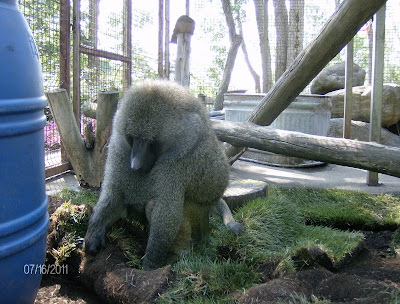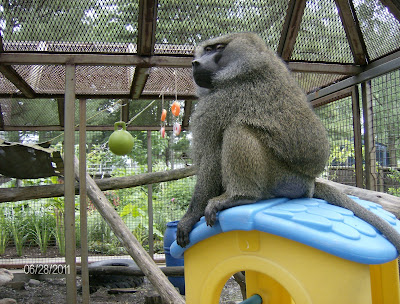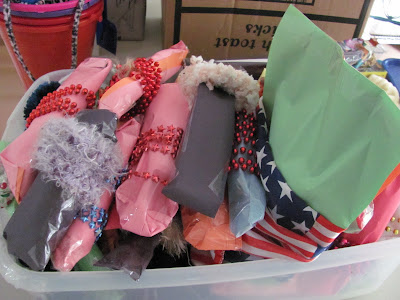
Marlon, a 10-year-old chimpanzee at the New Iberia Research Center in Louisiana.
Published: November 14, 2011
NEW IBERIA, La. — In a dome-shaped outdoor cage, a dozen chimpanzees are hooting. The hair on their shoulders sticks straight up. “That’s piloerection,” a sign of emotional arousal, says Dr. Dana Hasselschwert, head of veterinary sciences at the New Iberia Research Center. She tells a visitor to keep his distance. The chimps tend to throw pebbles — or worse — when they get excited.
This week: Beyond planet Earth, taking care of our closest relatives, and when your brain just won’t deliver.
The Science Times

Chimps’ similarity to humans makes them valuable for research, and at the same time inspires intense sympathy. To research scientists, they may look like the best chance to cure terrible diseases. But to many other people, they look like relatives behind bars.
Biomedical research on chimps helped produce a vaccine for hepatitis B, and is aimed at one for hepatitis C, which infects 170 million people worldwide, but there has long been an outcry against the research as cruel and unnecessary. Now, because of a major push by advocacy organizations, a decision to stop such research in the United States could come within a year. As it is, the United States is one of only two countries that conduct invasive research on chimpanzees. The other is the central African nation of Gabon.
“This is a very different moment than ever before,” said Wayne Pacelle, president and chief executive of the Humane Society of the United States. “Now is the time to get these chimps out of invasive research and out of the labs.”
John VandeBerg, director of the Southwest National Primate Research Center in San Antonio, one of six labs that house chimpanzees, agreed that this is “a crucial moment.” Any of several efforts by opponents “could be the cause of a halt in all medical research with chimpanzees,” he said.
The Humane Society of the United States and other groups pushed the National Institutes of Health to commission a report on the usefulness of chimps in research, due this year. The society also joined with the Jane Goodall Institute, the Wildlife Conservation Society and others to petition the federal Fish and Wildlife Service to declare captive chimps endangered, as wild chimps already are, giving them new protections. A decision is due by next September.
In addition, the Great Ape Protection and Cost Savings Act, now in Congress, would ban invasive research on all great apes (including bonobos, gorillas and orangutans). Representative Roscoe Bartlett, a Maryland Republican who is one of the bill’s sponsors, says it would save taxpayers $30 million a year spent on chimpanzees owned by the government.
Mr. Pacelle says that invasive research on chimpanzees is expensive, that there are alternatives and that chimps in research studies suffer painful procedures and isolation. “This is an endangered species that is closer than any other species genetically,” he said. “And we shouldn’t abuse our power.”
Dr. VandeBerg, on the other hand, says that stopping research with chimps would be a threat to human lives.
“Any reduction in the rate of development of drugs for these diseases will mean hundreds of thousands of people, really millions of people, dying because it would be years of delay,” he said.
If human lives can be saved, Dr. VandeBerg said, “it would be grossly unethical not to do research” on chimpanzees.
There are 1,000 chimps housed in research facilities in the United States, including at the New Iberia Research Center. The center, part of the University of Louisiana at Lafayette, occupies 100 acres in the heart of Cajun country about 130 miles west of New Orleans. It houses 360 chimpanzees, 240 of which belong to the university and 120 to the N.I.H., and more than 6,000 other primates, mostly rhesus macaque monkeys. It has faced accusations of chimp mistreatment in the past, and some violations of animal care standards were found, and corrected, according to Department of Agriculture inspections. The latest, in July, found some outdated drugs for the animals.
On a recent visit, some of the chimpanzees were in 34-foot-diameter geodesic domes, some in smaller outdoor cages, and some, less than 10 at that time, said Dr. Thomas J. Rowell, the director of the center, were in active studies and held in indoor cages about 6 feet by 5 feet and 7 feet high, one chimp per cage. * The physical procedures involved in the studies, he said, involved injections, blood samples and liver biopsies, the latter done under sedation.
Many studies last only a couple of days, Dr. Rowell said, but a few are longer. A study near completion had been going on for four months. He passionately defended the center’s treatment of chimps, emphasizing the veterinary care and efforts to enrich the chimps’ lives with more interesting environments.
Using captive chimpanzees for research in this country dates to the 1920s, when Robert Yerkes, a Yale psychology professor, began to bring them into the country. During the 1950s, the Air Force began to breed chimps for the space program, starting with 65 caught in the wild. Chimps were also bred for AIDS research in the 1980s, which met a dead end. By the mid-1970s, support for preservation of threatened species had grown, and the importing of wild-caught chimps was prohibited. In 2000, a federal law was passed requiring the government to provide for retirement of chimps it owned after their use in experiments was over, and Chimp Haven opened near Shreveport, La., to care for these chimps and others.
It was an attempt to bring some semiretired chimps at the Alamogordo Primate Facility in New Mexico back into the research pipeline that prompted part of the recent surge of opposition. The N.I.H. wanted to move about 200 chimps it owned from Alamogordo to the San Antonio center, which is part of the Texas Biomedical Research Institute. The Humane Society lobbied to prevent the move, and the N.I.H. relented, asking the Institute of Medicine, an advisory board, for the report on chimps in experimentation this year.
Chimp Haven, one potential retirement destination, now has 132 chimps on 200 acres of pine woods. Chimps live in a variety of cages and enclosures, including concrete-walled play yards of about a quarter of an acre, open to the sky, and two forested habitats, one four acres and the other five, bounded by a moat and fences. But chimps at research centers might not move at all, even if research is stopped. They might simply stay where they are, exempt from invasive studies.
Whatever the decision, both researchers and advocates know that chimps are only one tiny piece of animal research, one part of a bigger debate.
Kathleen Conlee, senior director for animal research issues at the Humane Society, says that the current discussion about chimps points the way to the future. “This,” she said, “is the kind of rigorous analysis we should be applying to all animal research.”
This article has been revised to reflect the following correction:
Correction: November 14, 2011
A previous version of this article gave an incomplete name for a bill now in Congress. The bill is called the Great Ape Protection and Cost Savings Act of 2011.
*The attached photo shows one of the cages the rescued chimps (now at the Fauna Sanctuary) lived in for years while enduring painful experiments. The cages (including the floors) were made of metal bars; they were hauled up to the ceiling each day where they then lived in isolation-- no enrichment or direct contact with any other chimps (though in the wild they live in extended families).
** This year’s film ” Project Nim” shows the quality of the lives of some of the scientists doing these experiments.







































 when he
when he  was two years old. Knuckles had been diagnosed with cerebral palsy and had difficulty walking. Grub, Kenya and Noelle all accepted Knuckles into their group for limited playtimes. Grub was the most gentle with him and seemed to be fully aware of his limitations and specialness. However, when Mowgli joined the group, he was not so gentle with Knuckles and would playfully try to poke him or pull Knuckles' hair through the wire mess when Knuckles visited Grub's group. But, Grub would keep an eye on Mowgli, and if he saw that Mowgli was getting to rambunctious with Knuckles, Grub would either gently put his hand on Mowgli's arm to stop him...or give him a stern eye to warn Mowgli not to touch Knuckles.
was two years old. Knuckles had been diagnosed with cerebral palsy and had difficulty walking. Grub, Kenya and Noelle all accepted Knuckles into their group for limited playtimes. Grub was the most gentle with him and seemed to be fully aware of his limitations and specialness. However, when Mowgli joined the group, he was not so gentle with Knuckles and would playfully try to poke him or pull Knuckles' hair through the wire mess when Knuckles visited Grub's group. But, Grub would keep an eye on Mowgli, and if he saw that Mowgli was getting to rambunctious with Knuckles, Grub would either gently put his hand on Mowgli's arm to stop him...or give him a stern eye to warn Mowgli not to touch Knuckles. Grub's gentle nature was also evident in his love of dogs. As a youngster, Grub grew up around several dogs that lived at the tourist attraction. He giggled in games of chase with the dogs and would be "over the moon" when they licked his face! As he grew in strength, we had to limit his direct contact for the safety of the dogs. Grub had a golden retriever friend in Wauchula (Joe) who was the happy recipient of monkey chow biscuits that Grub would toss to him... and then play "chase" as Joe ran around the outside of Grub's habitat.
Grub's gentle nature was also evident in his love of dogs. As a youngster, Grub grew up around several dogs that lived at the tourist attraction. He giggled in games of chase with the dogs and would be "over the moon" when they licked his face! As he grew in strength, we had to limit his direct contact for the safety of the dogs. Grub had a golden retriever friend in Wauchula (Joe) who was the happy recipient of monkey chow biscuits that Grub would toss to him... and then play "chase" as Joe ran around the outside of Grub's habitat.
 for mask-making. He learned to make masks when a volunteer in Miami, made one for him from a paper plate when he was only three years old. He didn't want to wear it...he wanted her to put it on. From that one time, watching the volunteer tear out eye holes, he began to experiment with paper bags, cereal boxes, wrapping paper...and when he couldn't find paper in his habitat, he would pick up fallen leaves and m ake tiny masks from those. His joy seemed to be in presenting these "Grub-masks" to visitors at the Center and watching them wear the masks. In fact, he made a beautiful mask from a red cereal box for Jane Goodall when she visited him in 2005. I will miss those special gifts from Grubby.
for mask-making. He learned to make masks when a volunteer in Miami, made one for him from a paper plate when he was only three years old. He didn't want to wear it...he wanted her to put it on. From that one time, watching the volunteer tear out eye holes, he began to experiment with paper bags, cereal boxes, wrapping paper...and when he couldn't find paper in his habitat, he would pick up fallen leaves and m ake tiny masks from those. His joy seemed to be in presenting these "Grub-masks" to visitors at the Center and watching them wear the masks. In fact, he made a beautiful mask from a red cereal box for Jane Goodall when she visited him in 2005. I will miss those special gifts from Grubby.















